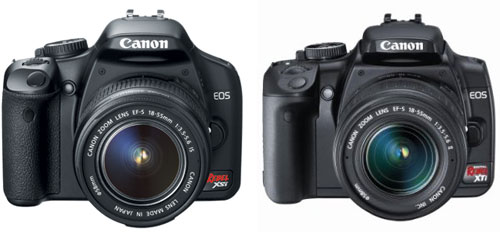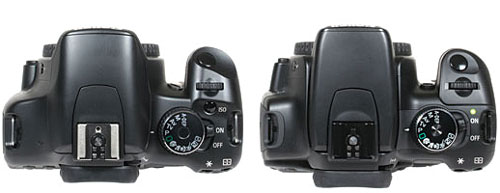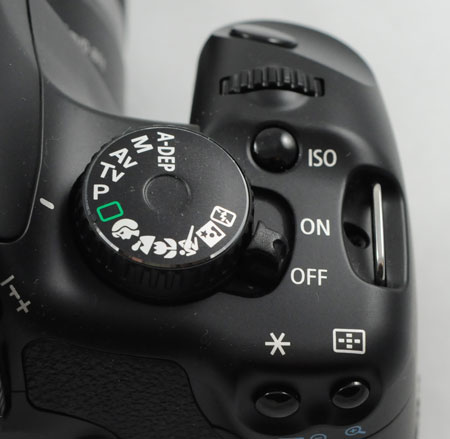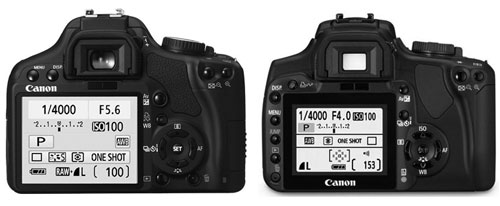Canon XSi: 12.2 Megapixels, Image Stabilized Lens, and Double Live View
by Wesley Fink on May 5, 2008 3:00 AM EST- Posted in
- Digital Camera
XSi compared to XTi
As the top-selling model in the DSLR universe, each new Canon builds on the previous model's footprint and features. This evolutionary approach keeps new Rebels familiar, but Canon also has managed to keep their entry flagship fresh with the latest must-have features and new Canon innovations.

The XSi is more rounded and less angular than the XTi. It is also slightly larger than the XTi to accommodate the larger 3" LCD.
| Canon XSi vs. Canon XTi | ||
| XSi | XTi | |
| Dimensions | 129 x 97.5 x 61.9mm 5.1 x 3.8 x 2.4" |
126.5 x 94.2 x 65mm 5.0 x 3.7 x 2.6" |
| Weight | 475g (16.8oz) - Body only 525g (18.5oz) - with Battery |
510g (18oz) - Body Only 556g (19.6oz) |
The XSi is 2.5mm wider and 3.3mm taller than the XTi. However, it is 3.1mm less deep and 35g lighter than the current XTi. The overall impression is the XSi is slightly larger than the XTi, and it is surprisingly light. The rubber grip cover is now more "texturized" with subtle changes to the shutter release depression and angle. The grip is more comfortable to hold for larger hands (still improved by adding the grip), but it is a good fit for smaller hands.
Build quality seems a cut above earlier Rebels and the appearance is definitely classier and more in keeping with the rest of the Canon DSLR line. The XSi has been described as looking like a mini 40D and that is an apt description. The XSi is also the most rugged Digital Rebel ever built with a stainless-steel chassis and a glass-reinforced engineering plastics body.

The XTi ON LED is gone, something that may matter to some users. If you look closely you can see that the shallower XSi is entirely due to the stubbier pentamirror/flash housing, which does not overhang as much as in the XTi.

The XSi adds an ISO button just above the on-off switch. ISO is also now displayed in the viewfinder (finally!).

The biggest changes in the XSi are on the back where the new 3" LCD looks absolutely massive compared to the XTi's 2.5" screen. The 3" screen is the same size and specifications as the Canon 40D screen. It is also the largest screen in its class - the Nikon D60 and Olympus 510/420 are 2.5", while the Sony A350/300/200 and Pentax K200D are 2.7".
The larger screen on the XSi required a complete rearrangement of rear buttons as well. There are no longer buttons on the left and the Menu and Display buttons are now at the top left of the screen.
The right side control buttons and layout are basically the same as the XTi, with the addition of the playback and delete (trash) buttons at the bottom right of the screen. The drive/timer button has been reassigned to a directional pad button and the old button is now assigned to White Balance. In a quick glance at the XSi rear you would think it has been simplified, as it looks as if there are fewer buttons. However, all the buttons and functions are still there; they are just rearranged.

The XSi is the first Canon camera to use SD cards, a break with all previous Digital Rebels that used Compact Flash cards. This is really not a handicap at all since SD cards are now priced about the same as Compact Flash. The latest Class 6 SDHC cards are also very fast, just like the high-speed CF cards. All test shots with the XSi used a 16GB Class 6 SDHC card for image storage. The operation was trouble free and very fast.

XSi introduces a new battery that is incompatible with past models. The electrical contacts are contained in the bump on the battery - presumably to prevent accidental contact and discharge in the camera bag. The new LP-E5 (50g) rechargeable battery weighs about the same as the NB-2LH (46g) which powered the XT and XTi models. However, battery output increases about 50% to 1080 mAh compared to the 720 mAh of the NB-2LH. Battery life was not an issue with the XTi as Canon CMOS sensors are justly famous for low power consumption. The XSi battery life is even better, with plenty of reserve for driving the 3" LCD and Live View.

With the new LP-E5 battery also comes a new battery grip called the BP-E5. Then new BP-E5 works only on the XSi; it is incompatible with the earlier Digital Rebel grip. The earlier BP-E3 will not work on the XSi.
The new BP-E5 requires the battery cover be removed for mounting. The grip has a place to store the battery cover on the grip so it is not lost. Power for the grip is either one or two LP-E5 batteries. The grip also comes with an AA battery holder for six AA-size batteries as an alternate power source. We tested the grip with high-capacity rechargeable AA batteries and they worked fine as a power source.
It is definitely worth mentioning that the grip with two BP-E5 batteries is still extremely light, but the two dedicated batteries pack a wallop with 2160 mAh available. Unlike the Sony proprietary batteries, the new LP-E5 batteries are already available OEM from third party vendors.
An added feature of the BP-E5 is that it does provide some weather sealing, unlike the previous Digital Rebel grip. While Canon does not make a big deal of the feature, the XSi does provide some weather sealing, which is more a prosumer model feature.










56 Comments
View All Comments
pinto4402 - Monday, May 5, 2008 - link
Your observation about Canon's overly warm/red WB in tungsten lighting is shared by many camera reviewers/users. It's a "problem" that has been noted for a long time. Some people actually prefer the overly warm colors, though. I'm sure this is the reason why Canon has never fixed their WB.Deadtrees - Monday, May 5, 2008 - link
"Working range AF specifications are the same EV range of -0.5EV to 18EV. However, the 40D adds an additional diagonal cross-type sensor with greater precision for f2.8 lenses, providing better support for fast Canon L lenses."- Not trying to be picky or anything but that is somewhat misleading as not all L lenses have aperture values faster than f/2.8.
-------------------------------------------------------------------
"Overall, the Sony A350 actually does better against the Canon XSi than we really expected and acquits itself quite well for a higher resolution sensor that should be showing greater noise than the Canon XSi. Resolution and noise control to ISO 1600 on the Sony holds its own against a sensor maker than has been the low-noise standard since DSLRs began."
- Keep in mind that A350 utilizes quite agressive noise deduction algorithms resulting smudged water color like images. If you think less noise is good no matter what, I guess it's not so bad. But, what about details that are lost? Do you really want over 10mp dslr images to show details as cell phone cameras? Hell, in that case, even point-and-shoot panasonic cameras that are known for crazy noise reduction algorithm can compete head to head with Nikon D3.
---------------------------------------------------------------------
BTW, I really suggest you to change the test subject. It's glossy coated hardboard papers which makes it virtually impossible to see the loss of details caused by insance noise reduction algorithms.
Lord 666 - Monday, May 5, 2008 - link
Wes,If you are comparing the XTi vs. XSi vs. 40D, why not include the D300 as well to compare against?
Wesley Fink - Monday, May 5, 2008 - link
We will include the D300 results in Part 2 of our Digital Sensor article. We will be comparing resolution and noise in different sensor categories, such as 14 megapixel, 12 megapixel, and 10 megapixel.I did toy with the idea of including the D300 in comparisons in this review, but I figured Canon to past Canon XTi to top Canon prosumer 40D was a bit more logical than a $800 body to a $1800 body. I'll leave that comparison for the digital sensor article.
complectus - Monday, May 5, 2008 - link
Is that a Frank Lloyd Wright house in 2 of the Sample Images?Wesley Fink - Monday, May 5, 2008 - link
Yes it is Frank Lloyd Wright. I am fortunate that a real Wright house is in my neighborhood. The furniture was also custom built for the rooms in th eWright house, as was typical of many of his home designs.It was built in the early 1900's and is contemporary to the other homes in the photographs. I figured someone would catch it.
pinto4402 - Monday, May 5, 2008 - link
For about five minutes, I was interested in the Xsi as a lightweight backup camera body for event photography. However, the lack of a CF card slot completely nixes this idea. It doesn't make any sense for Canon to switch from CF to SD, other than to attract P&S owners who want to migrate to a DSLR. By doing so, however, Canon effectively excluded us existing DSLR owners who already have many of their lenses and who would be more likely to purchase. I can tolerate the Xsi's plastic body, but I'm not going to invest in new storage media just to use this camera.Wesley Fink - Monday, May 5, 2008 - link
You can buy a 16GB class 6 hi-speed SD card for $55, a 4GB Class 6 for about $20, or an 8GB for around $30. I can't believe that small expense would keep you from buying and using the XSi if you really wanted to.Nikon uses SD on the D80 and D60, Pentax uses it on the K20D and K200D. Sony still uses CF, but new Sony lenses cost a lot more than today's cheap SD and CF memory.
RDaneel - Monday, May 5, 2008 - link
I have no problem with AT doing camera reviews, I think it's a valuable perspective for hobbyists and prosumers. Obviously AT isn't going to review $1500 lenses...That being said, this review reads more like Canon ad copy than a real comparative review. There isn't any serious examination of the image quality, and it feels like more effort is spent in comparing the number of AF points and megapixels than really looking at the camera as a DSLR system or really talking about IQ. Just kind of a disappointment, normally the objectivity on AT is a bit better. Did the author get to keep the free press sample? ;)
Wesley Fink - Monday, May 5, 2008 - link
There was no Press sample - not even a loaner. We had to buy the XSi that was reviewed. The same goes for the Nikon D60 and Sony A350 that were compared to the XSi. Since we bought them all we owe nothing to any manufacturer.The XSi won't replace my D300 or my Pentax K20D, but it is a really superb entry camera.